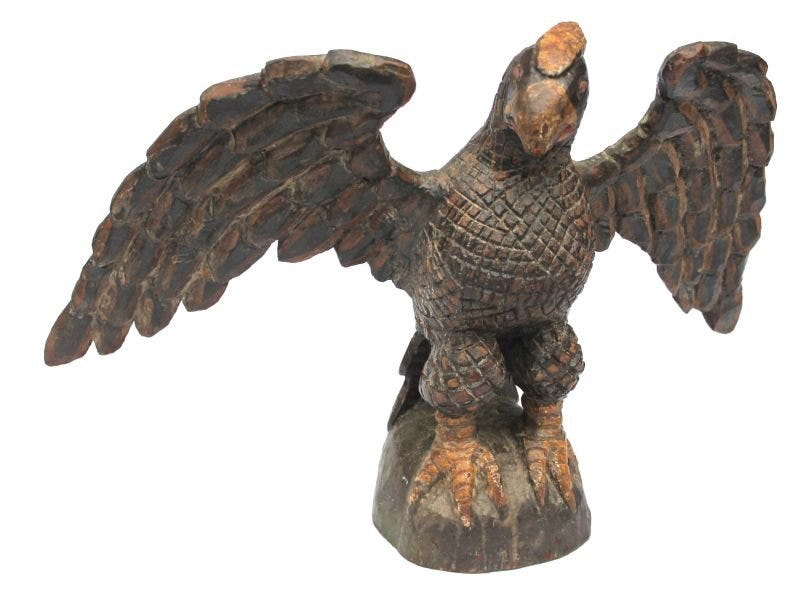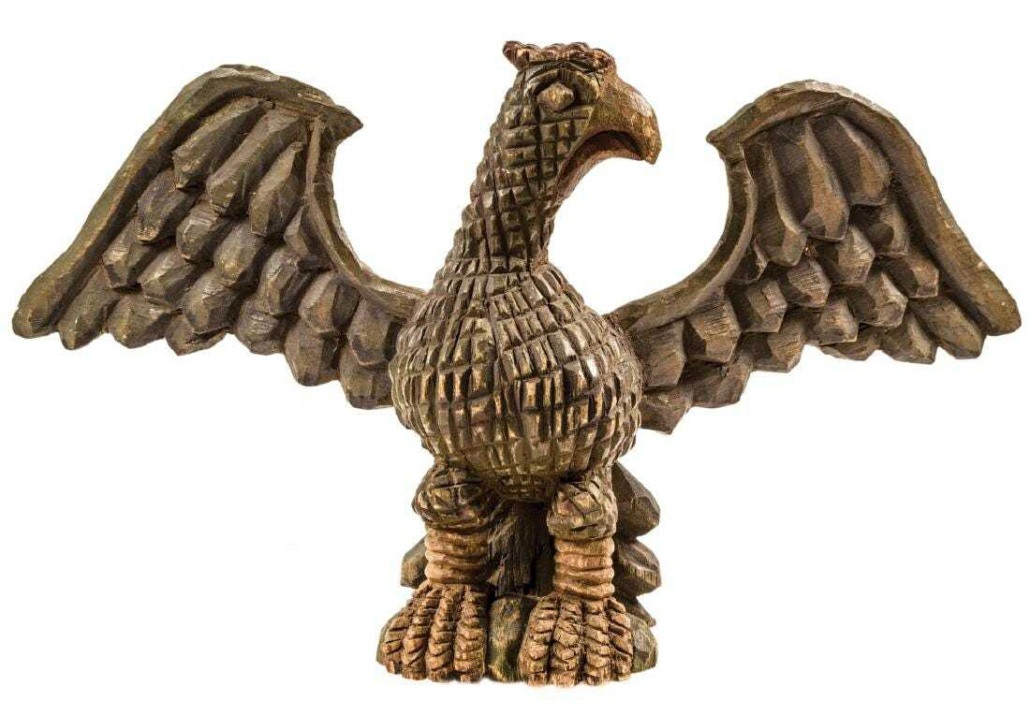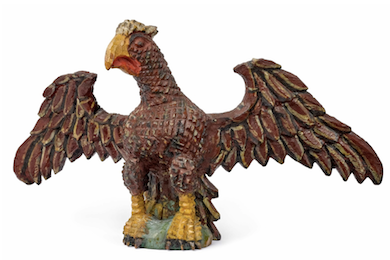
NEW YORK — Itinerant carver Wilhelm Schimmel (Germany and America, 1817-1890) was certainly a colorful character. He was known for having a rough and tumble life, punctuated by heavy drinking, bouts with the law, and possibly cheating death a few times. He emigrated to Pennsylvania from Germany around 1860 and became known as one of America’s most talented folk art carvers. His eagle wood carvings with fine detail and crosshatching are particularly coveted.
Few motifs are more quintessentially patriotic in America than the eagle. The noble bird was a common symbol in the 19th century and during Schimmel’s lifetime, when patriotic fervor reached a peak in the years surrounding the country’s centennial.
Schimmel carved all sorts of animal figures, but his spread-winged eagles were among his most popular works. He made them in various sizes, from a few inches tall to those boasting a wingspan of nearly two feet.
“Using a common folding pocket knife, Schimmel carved deep, angular cuts to articulate his eagle, then applied a white primer and common house paints,” according to the Metropolitan Museum of Art in New York City. His protege, Aaron Mountz, followed in his footsteps and brought the art of carving figures into the early 20th century. Both carvers’ works are highly collectible.

While Schimmel’s works were apparently well received in his day, they were not seen as valuable works of art, and he bartered them or sold them at little cost. He apparently didn’t hold down a regular job. He moved often from farm to farm, usually staying with families who had German backgrounds, and he would present them with wood carvings in exchange for food and other necessities. While the bartering system worked for him, he lived a hand-to-mouth existence and died in a poorhouse in Carlisle, Pennsyvlania in August 1890. His obituary in the local paper referenced his talent as well as his temper and his penchant for getting into trouble. It included this excerpt: “His only occupation was carving heads of animals out of soft pine wood he would sell for a few pennies each, he was apparently a man of very surly disposition.”
Several decades after Schimmel’s death, art collectors began taking notice of his work and started snapping up his carvings. Now it is recognized as true folk art. Ron Pook, founder of Pook & Pook, Inc. in Downingtown, Pennsylvania, said, “His allure lies in the folk nature of his primitive work and his colors. There is also some cachet based on the fact that he was often intoxicated and would sleep in people’s barns in return for a carving.”

Schimmel never signed his eagles. He reportedly didn’t see the need for this, nor did his customers, although they certainly knew and appreciated that his carvings were done by hand. Of the roughly thousand or so carvings Schimmel is said to have made, about a hundred or so have survived. He often painted them in bright colors with household paints, leaving some parts bare to show the natural wood. His works can be recognized by his dramatic crosshatching style of carving on the eagle’s chest, neck, and legs–a distinctive detail that acts as an alternative signature.
By the 1920s, his European-style carvings held the attention of folk art collectors and prescient buyers. Abby Aldrich Rockefeller and Elie Nadelman were among his earliest admirers. Museums with Schimmel carvings in their collections include the American Folk Art Museum in New York, the Abby Aldrich Rockefeller Folk Art Museum in Williamsburg, Virginia, the Philadelphia Museum, and the Shelburne Museum in Shelburne, Vermont.

The event that really kicked off demand for his work was a two-day sale in the fall of 1927 at an inn in Chambersburg, Pennsylvania, which was said to be the first public sale of his works. A total of 10 carvings were reportedly offered. Top local antiques dealers reportedly scouted the region, buying his works from first- and second-generation owners whose families received them directly from Schimmel. Several dealers sold pieces to leading New York dealer Edith Halpert, which she then sold to her affluent clients, such as Rockefeller. A major exhibition by Rockefeller in autumn 1965 in Williamsburg, Virginia cemented Schimmel’s legacy in the folk art world.
“The market for Schimmels might be a little softer than several years ago ,but remains pretty strong as evidenced by today’s prices,” Pook said, noting that in May 2021, a Schimmel carved rooster sold for $15,990 and a carved squirrel brought $12,300. “He is most well known for carving eagles and eaglets, but has done human figures and other animals.” Pook sold a Schimmel eagle with much of its original paint for $48,000 plus the buyer’s premium in October 2019.
Christie’s New York set an auction record in September 2016 at when it sold a 26-in eagle carving attributed to Schimmel for $427,500. As none of his works were signed, Schimmel carvings can only be attributed to him. Those for which the family provenance can be directly traced back to him are especially desirable and bring top dollar.
The eagle has long been a favorite subject matter for artists and as a symbol of freedom, it was likely especially meaningful to Schimmel, who settled in America to start a new life. These primitive but skilled carvings that he sold for pennies on the dollar or gave away are widely appreciated today for their artistic merits.
# # #


